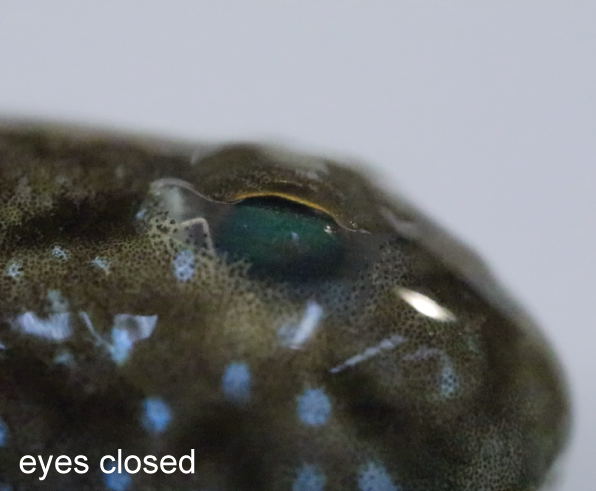Mudskipper Blinks
The fish that can wink at you!
THis amphibious Mudskipper blinks by retracting their eyes into their heads!
Mudskippers are small fishes that have evolved to spend large stretches of time on land, independently from tetrapods. Alongside their ability to traverse the land, mudskippers have evolved numerous features that allow them to thrive out of the water. One of the notable behaviors is their ability to draw their eyes into their heads in what looks like a blink. Blinking is an important behavior found in many animals that helps keep the eyes wet, clean, and protected. However, most fish can’t blink! So how and why did these tiny mudskippers evolve the ability to blink? And what can that tell us about the evolution of blinking in humans and early tetrapods?
“We found that, just like humans, mudskippers blink more frequently when confronted with dry eyes. What’s incredible is that they can use their blinks to wet the eyes, even though these fish haven’t evolved any tear glands or ducts. Whereas our tears are made by glands around our eyes and on our eyelids, mudskippers seem to be mixing mucus from the skin with water from their environment to produce a tear film.”
Through a comparative morphology, high-speed videography, and experimental biology approach our research shows that small tweaks to relatively simple morphology can achieve a novel behavior. We find that blinking in mudskippers is a multifunctional innovation and the evolutionary origins of blinking in mudskippers and tetrapods is possibly due to the transition to living on land.
This work was made possible thanks to a huge team of important collaborators led by Brett Aiello (Seton Hill University) and Thomas Stewart (Penn State University), and supported by the Bhamla Lab, Neil Shubin (University of Chicago), Simon Sponberg (Georgia Institute of Technology), and John Morris (Westmead Hospital). We also worked alongside a large team of Georgia Tech undergraduate students as part of the Living Dynamical Systems Vertically Integrated Project Team, which included Jeff Gau, Kenji Bomar, Shashwati da Cunha, Harrison Fu, Julia Laws, Hajime Minoguchi, Manognya Sripathi, Kendra Washington, and Gabriella Wong.
“The transition to life on land required many anatomical changes, including changes for feeding, locomotion and breathing air. Based on the fact that mudskipper blinking, which evolved completely independently from our own fishy ancestors, serves many of the same functions as blinking in our own lineage, we think that it was likely part of the suite of traits that evolved when tetrapods were adapting to live on land.”
This project was featured in Nature, National Geographic and more.
“Blinking is a reflection of a bigger question. How did major evolutionary transitions occur that enabled organisms to inhabit basically every environment on this planet? What we learned is you don’t need the evolution of a lot of specialized musculature or glands; evolution can tinker with the structures that are already there, allowing them to be used in a new way and for a new behavior.”
Major questions
1) How do mudskippers blink?
2) Why do mudskippers blink?
3) How does fish blinking inform the evolution of blinking in humans?
What we’ve discovered
Mudskippers have the same muscles as any other fish, but they can use them differently!
Analyses of the anatomy of mudskippers and their close relatives show that they use the same eye muscles that other fish have around their eyes to perform their blinks. Mudskippers blink by lowering the eye and raising a lower membrane called the “dermal cup”.
Blinking helps mudskippers keep their eyes wet, clean, and protected!
Through experiments, we showed that mudskippers blinked more often in environments where evaporation is high. Mudskipper blinks can clean any about 97% of foreign particles from the corneal surface. And if something touches their eyes, mudskippers will blink in under 30 milliseconds, about as fast as humans, to try and protect the eye.
Mudskippers and tetrapods probably both evolved blinking to keep their eyes working while living on land!
About 375 million years ago, one group of fishes left the water and began to live on land which eventually give rise to amphibians, birds, reptiles, and mammals (which includes humans). Studying this water-to-land transition is challenging because scientists are limited to fossil records. However, mudskippers evolved their ability to survive on land independently of tetrapods! Our research shows that blinking in mudskippers is functionally convergent to the evolution of blinking in tetrapods.
“We find that a single behavior can be deployed to accomplish three complex, distinct functions. These results not only help humans understand our own history, but also help us reevaluate the adaptations necessary for major transitions in the evolutionary history of vertebrates, like moving from water to land.”
A mudskipper (Boleophthalmus caeruleomaculatus) resting at the water’s edge. Taken at Mai Po Nature Reserve, Hong Kong. (Image Credit: Daniel J. Field)
Read the paper
The origin of blinking in both mudskippers and tetrapods is linked to life on land. PNAS (2023).










